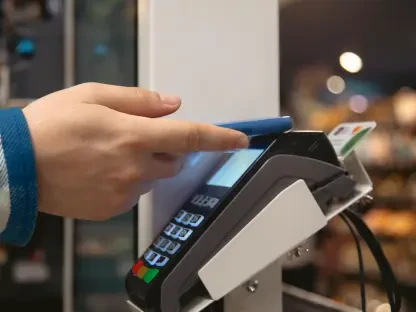The retail landscape has experienced significant transformation due to technological advancements. Consumers now expect a seamless buying experience, transitioning smoothly from search to purchase across various platforms. This demand compels retailers to innovate, integrating technology to ensure both ease and satisfaction in the shopping journey. As shoppers navigate between online and brick-and-mortar channels, retailers must balance these avenues, defining the future of commerce. Understanding this trend is pivotal for businesses aiming to cater to modern consumer expectations, offering seamless and integrated experiences.
Transforming Online Shopping
The Rise of Search-to-Purchase Functionality
The development of search-to-purchase functionality has revolutionized the way consumers engage with online shopping platforms. It provides a streamlined experience where users can search for products and complete transactions without leaving the page, minimizing interruptions and enhancing convenience. This functionality has been particularly appealing to younger demographics, who are accustomed to quick and efficient interactions on social media platforms. Retailers implementing this functionality harness the power of platforms like Instagram and TikTok to facilitate immediate purchases, responding to the fast-paced demands of today’s shoppers. By minimizing barriers between product discovery and checkout, businesses are seeing increased consumer engagement and satisfaction.
The role of seamless search-to-purchase technology extends beyond social media, affecting broader e-commerce strategies. Retailers invest in sophisticated algorithms and user-friendly interfaces to maintain competitive edges in this rapidly evolving landscape. As consumers navigate the digital space, they expect intuitive experiences that complement their buying habits. Technology companies like Global Payments collaborate with retailers to develop seamless digital commerce solutions, ensuring that buyers transition easily from interest to sale. The emphasis on efficiency resonates with consumers, laying the groundwork for a sales environment that aligns with contemporary expectations.
Embracing Live Commerce
Live commerce represents another frontier in the evolution of seamless shopping, offering real-time interaction between retailers and consumers. This model resembles traditional television shopping channels but is powered by digital innovation. Online platforms facilitate dynamic interactions, enabling viewers to engage directly with products. These immersive experiences meet consumers’ desires for a more personal touch in digital shopping. The success seen in markets like China, where live commerce is well-established, inspires worldwide adaptation of this approach. Retailers are discovering new ways to interact with and convert audiences, forging meaningful connections that translate into sales.
The adoption of live commerce reflects the increasing consumer appetite for engagement and real-time experiences. As brands like Zara and Dyson incorporate live commerce into their broader marketing efforts, they witness direct impacts on their bottom lines. The collaboration between TikTok Shop and Canvas Beauty, generating significant revenue through a livestream event, exemplifies the success of interactive buying. This strategy not only enhances consumer engagement but also drives brand visibility and loyalty. Retailers explore varied approaches to integrate this strategy within their sales tactics, thereby influencing consumer behavior and optimizing conversion rates.
The Enduring Appeal of Physical Stores
The Persistent Importance of Brick-and-Mortar
Despite the growth of digital shopping channels, physical retail locations maintain their importance within the modern shopping experience. Data indicates that physical stores remain integral to consumers’ buying journeys. These locations provide tactile interactions and personal connections that digital platforms cannot replicate. For many, the tangible elements of shopping in-store offer a unique and appealing dimension to the retail experience. This blend of sensory and social engagement fosters deep emotional connections with brands, leading to lasting loyalty.
Physical stores also serve as critical touchpoints that validate brand experiences and enhance multichannel strategies. Many brands have recognized the updated role of physical spaces—transcending beyond mere points of purchase to becoming immersive experience centers. Retailers invest in crafting specialized in-store environments, prioritizing customer curiosity and engagement as pathways to brand strength. While embracing digital innovations is crucial, melding these advancements with continued investment in physical spaces ensures businesses meet diverse consumer needs.
Bridging the Digital and Physical Divide
The overlap between digital and physical retail strategies is critical for today’s seamless shopping experience. As retailers invest in both, they are better positioned to meet growing consumer preferences. The integration of digital interfaces in-store, enabling features like mobile payments and interactive displays, reflects the blurring lines between online and offline shopping. Consumers appreciate the flexibility to explore and purchase through their preferred method, emphasizing the need for cohesive strategies that blend different shopping modalities.
Retailers like Global Payments implement technology that bridges the digital-physical divide, supporting smooth, cross-channel transactions. This strategy emphasizes consumer satisfaction, ensuring easy transitions between online and in-person purchases. As shopping habits evolve, businesses leverage technology to address the myriad expectations of consumers in this unified landscape. By focusing on integrated experiences, retailers create valuable and enduring customer relationships based on convenience and choice.
Toward a Seamless Retail Future
In recent years, the retail industry has undergone a profound transformation driven by advancements in technology. Consumers today expect a seamless shopping experience, moving effortlessly from the initial search to the final purchase across a variety of platforms. This shift in consumer expectations pushes retailers to be innovative, employing technology to create a shopping journey that is both easy and satisfying. As buyers switch between online stores and physical locations, it’s crucial for retailers to find the right balance between these channels, ultimately shaping the future of commerce. For businesses that want to thrive in this ever-evolving market, understanding and keeping up with this trend is essential. Offering smooth, integrated experiences is crucial to meeting contemporary consumer demands. Retailers who manage to integrate these elements successfully will not only improve customer satisfaction but also position themselves strongly in the competitive landscape of modern commerce, securing their place in the future market.









